At the recent Apex Expo on T&M technologies for SMT production, some companies such as Test Research Inc (TRI) demonstrated products with X-ray inspection technology that can see through printed circuit boards (PCBs) and hard-to-inspect components to check their connections to the PCB. Such test systems enable in-line inspection of high-density components such as flip chips (controlled collapsed chip connections), ball grid arrays (BGAs) and micro-components down to 0201 and 01005. These use X-ray penetration to capture images through several cameras positioned at different angles. Software is then used to analyse the slice images and calculate the different slice heights to inspect for PCB defects.
Another technology that has been around for over three years, but has suddenly gained more popularity, is 3-D imaging. According to a recent study by ITM Marketing, “The primary end-user applications for automated optical inspection (AOI) systems are solder-paste inspection and process optimisation. Increasingly, users want 3-D imaging in their systems.” Basically, in these systems, light is focused on the components to measure height, area and volume. Using software, the system analyses these images and calculates statistical process control (SPC) results in these areas. This information is then used to automatically decide whether a piece is perfect or needs to be rejected. Recent 64-bit 3D systems can inspect at a speed of 171 cm2 per second, with a 14-micrometre resolution.
It is important to note that one of the key reasons for the dramatic growth of AOI systems in the past year is the associated developments related to LEDs. LED illumination modules are now available in varying wavelengths and increased intensities. These are now the preferred light source for optical inspection, as they have a long life, consume less power, are stable over time, can be turned off or on instantaneously and controlled accurately.
Wireless: T&M for 3G/4G networks and equipment
The growth of wireless communications and network convergence has spurred the growth of wireless-capable T&M equipment for monitoring the quality-of-service (QoS) of mobile networks and testing the associated devices including phones. From protocol analysers and emulators to field testers, T&M and the related systems are all becoming wireless-savvy.
[stextbox id=”info” caption=”Innovative Products Launched Last Year”]
Qmax Semiconductor IC Test System
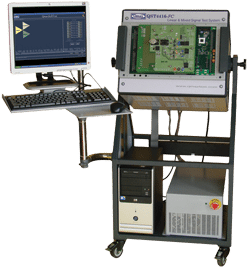
Indigenously designed and developed in India, Qmax’s QST4416-FC is meant to test precision electrical parameters (static and dynamic) for medium-power (around 100VA) semiconductor linear ICs, mixed-signal ICs and low-pin-count digital ICs. This semiconductor test system is used by design engineers to perform silicon-level wafer back-end testing, high-speed testing in IC production, outgoing quality assurance and incoming quality assurance. It includes exhaustive characterisation tools for R&D and statistical tools for production.
The QST4416-FC is designed using the latest high-speed, high-performance FPGA from Xilinx and high-speed SRAM technology for vector processing. It includes latest LabView 2009 software features and PCIe interface. Graphical user interface based programming eliminates the need for knowledge of any special programming language. The equipment is low-cost compared to its counterparts from other countries, as claimed by Qmax. (For details, visit www.qmaxtest.com)
Scientech Caddo Mini Lab
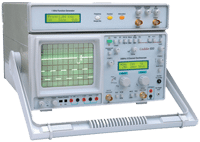
All-in-one is now becoming a buzzword in the T&M industry too. Scientech’s Caddo 820 is a single platform comprising oscilloscope, function generator and DC power supply in a single space-saving housing. It forms an independent test lab for many applications at a very affordable price point, as claimed by the company.
Caddo 820 is a microcontroller-based product with two-channel oscilloscope providing 40MHz trigger bandwidth and 1MHz function generator providing sine, square, triangular and DC outputs. (For details, visit http://www.scientech.bz/)
GW Instek Programmable AC/DC Power Source
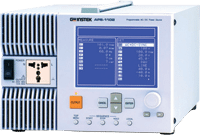
The APS-1102 multifunction programmable AC/DC power source from GW Instek comes with an arbitrary waveform generator. It allows programming of the outputs for simulation of a power source with abnormal variations. The APS-1102 includes a multifunctional and user-friendly software that supports remote control of panel operations, sequence editing and execution, arbitrary waveform editing and transfer, and data logging via USB interface. All these measurement readings and settings are displayed on a 14.5cm (5.7-inch) LCD screen simultaneously.
The equipment design includes a DC power source block, used to improve power factor of power supply input. The internal signal source with sequence function is used to provide AC+DC output. The APS-1102 can be used as an amplifier for external signal to generate power output depending on the selected mode and connected external signal. (For details, visit www.gwinstek.com/en/index.aspx)
AG Measurematics Computerised Lifting System
TFor the first time in India, a fully automated computerised system is designed to lift large to very large loads such as bridge piers, ships, railway wagons and locomotives in such a way that the lifted load remains oriented in the same way as it was standing on the ground. AG Measurematics’ CylSyn converts direction-control hydraulic valves into digitally actuated hydraulic switches.
The system has an integrated controller that incorporates a computer with touchscreen monitor, wireless keyboard and mouse, high-speed data acquisition and control device, pressure sensors and long stroke extension type linear displacement transducers. The application software based on Windows is preloaded on the computer and the load is measured through a special pressure transducer that uses thin-film technology. (For details, visit www.agmpl.com/)
[/stextbox]
Today, multiple-input, multiple-output over-the-air (MIMO OTA) emulators are available to support the increased performance and data rates of MIMO mobile terminals. These can test relatively small devices such as terminals, antennae, smart phones and laptops, and usually fit into a complete test system comprising transmitters, a radio channel emulator and an anechoic chamber that includes multiple antennae reasonably spaced from the device under test. Such a system can test a device without requiring cable connections to it, and also perform end-to-end test of the device’s antennae, radio frequency front-end, and base-band processor in a single operation. These systems are designed to meet the conformance-testing needs of several protocols including WCDMA, HSPA, 3GPP LTE, WiMAX and WLAN, and can help benchmark the performance of mobile devices for quality of service, data throughput, latency and spectrum availability.
Of late, we also find a few test systems capable of testing in parallel for various protocols including GSM, EDGE, CDMA One, W-CDMA, HSPA, HSPA+, CDMA-2000, EV-DO and LTE. Today’s 3G and 4G handsets and other portable devices include multiple radios representing numerous standards. Traditional test methods involve attaching dummy loads to the handsets and testing the various radios sequentially. New systems, on the other hand, will test all these in parallel, reducing the time taken to a fourth of the serial technique’s.
[stextbox id=”info”]Phased array will be the future of ultrasonic non-destructive testing. Although this technology has been spoken about for quite some time now, it is likely to gain traction in the near future and is therefore worth a watch[/stextbox]
Communications testing: Gigabit Ethernet and beyond
Speaking about the assessment of next-generation networks (NGN), gigabit Ethernet has taken the T&M world by storm. Test products for Past-10 gigabit networks are already being demonstrated.
At the Optical Fibre Communication Conference and Exposition and The National Fibre Optic Engineers Conference (OFC/NFOEC 2010), several such products were showcased, and experts even opined that 100 gigabit Ethernet will arrive in core networks this year.
Some companies demonstrated optical modulation analysers capable of 244Gbps data streams, while others showcased 10G Ethernet testers with electrical and optical ports for 10Mbps through 10Gbps links. Others products included 12.5Gbps parallel-channel BER testers, 40Gbps and 100Gbps BER testers, clock-recovery modules and clock synthesisers.
With so many greater-than-10G products on the market, it is time to think about co-existence. Not surprisingly, in March this year, several network test-equipment manufacturers, networking equipment manufacturers and service providers came together to form the Network Test Automation Forum, to define an open and advanced automation framework. The idea is to develop a software layer that resides between network equipment such as switches and routers and network test equipment. The software layer will act as a communications interface between the two, reducing the dependence of proprietary interfaces to integrate networks and test equipment.
[stextbox id=”info” caption=”Innovative Products Launched Last Year”]
Amp Tronics 3-in-1 Handheld
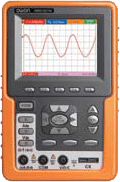
Multiple equipment packaged in a single handheld device is something very useful for field engineers.The HDS1021M from Amp Tronics can perform 18 automatic measurements with DSO, multimeter and cymometer packaged in a low-cost handheld device. The combination of DSP and DMM highly improves the test efficiency and convenience. It also features a TFT true-colour display and supports USB for data transmission. The Li-ion battery provides backup for up to six hours.
This 3-in-1 handheld is designed using ARM9 development board with a high-performance microprocessor. (For details, visit www.amp-tronics.com)
ArbStudio Waveform Generator From Lecroy
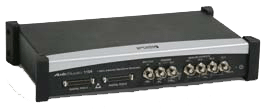
ArbStudio waveform generator from Lecroy provides 125MHz bandwidth, 16-bit resolution, two- and four-channel options, 1GS/s maximum sampling rate and memory depth of 2 Mpts per channel. It generates analogue and digital patterns with 18 and 36 channels, respectively. An intuitive interface helps you to create, edit and sequence waveforms. ArbStudio provides easy-to-use tools with built-in modulation capabilities like amplitude-shift keying (ASK), pulse-shift keying (PSK) and frequency-shift keying (FSK) that can be configured for any application.
ArbStudio is designed using a high-performance FPGA. Use of FPGA enables both arbitrary as well as digital synthesis modes in a single equipment, thereby reducing the price considerably. Some of Math and noise functions are built-in and can be combined with the waveforms. (Distributed in India by Electro Systems Associates (www.esaindia.com))
Kusam DMM for VFD Measurements
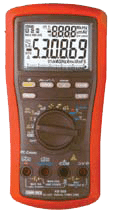
A new digital multimeter from Kusam Electrical Industries, DMM 869, offers a low-cost solution to almost 39 different measurements for any lab. Apart from the regular multimeter functions, it incorporates variable-frequency drive (VFD) measurements. In automation industries, for motor drive applications, VFD is used for power and energy savings. VFD measurements and VFD high-frequency-band voltage (100kHz) measurements help in ensuring the same.
The device also provides surge protection up to 12 kV, CAT4 protection up to 600V and CAT3 protection up to 1000V.
In order to design a high-end DMM with a variety of functions, a custom-made microprocessor technology has been used. (For details, visit www.kusamelectrical.com/)
[/stextbox]
Probes: Sharper than an eagle’s eye
Probes are becoming ultra-fine, super-fast and 3-D-capable. Consider some of the recent features being touted by popular brands. There are double-sided, 16-probe flying systems with 3-D probing and analogue, digital and boundary scan test capability on all probes. Then, there are systems for ultra-fine-pitch probing of loaded PCBs that can test down to 24mil centres and 15mil diameter targets, enabling 90 per cent better test coverage on dense, loaded PCBs.
Software has also begun to play an increased role in this space, enabling so-called ‘probe analysis.’ Such systems basically add an interactive, rules-based routine to assist layout engineers and test developers in identifying usable PCB locations for physical access. These also generate a comprehensive accessibility report that states whether adequate probe locations were identified for each net, highlighting mechanical rules violation, so that this information can be used for design improvements.
Phased-array ultrasonics: A nascent technology worth watching
According to a recent report by Frost & Sullivan, phased array will be the future of ultrasonic non-destructive testing. Although this technology has been spoken about for quite some time now, it is likely to gain traction in the near future and is therefore worth a watch.
A phased array is an advanced method of executing ultrasonic scans. Instead of a single transducer element, phased-array systems use an array of elements that can be pulsed sequentially. By creating interfering wave patterns, it is possible to electronically manipulate beams so that their direction and angle can be controlled. This enables more precise software control, inspection from multiple angles and inspection of complex geometries. Thanks to these abilities, experts are betting on the phased array to be the next big thing in non-destructive testing.
[stextbox id=”info”]Today’s 3G and 4G handsets and other portable devices include multiple radios representing numerous standards. Traditional test methods involve attaching dummy loads to the handsets and testing the various radios sequentially. new systems, on the other hand, will test all these in parallel[/stextbox]
Handheld instrumentation: From the lab to the field
While handheld instrumentation has been around for a few years now, the last year has seen their increased application, especially in wireless and pharmaceutical industries.
Consider the use of near-infrared spectrometers for testing certain chemicals in the pharmaceuticals industry. The removal of cartons to labs and their repacking used to cause several disturbances including introduction of dust between the satchels. However, the availability of handheld instruments has now made 100 per cent in-line testing possible today, avoiding a lot of unnecessary overhead.
Similarly, a range of wireless, handheld instruments have made it extremely easy to test the various components of next-generation networks.
Embedded instrumentation: Micro-instruments, macro benefits
Consider T&M instruments embedded as an additional feature in a chip. Embedded instruments are being recognised as a more cost-effective, efficient and agile solution to T&M needs of computing and communications industries.
As semiconductor devices and boards become more complex and crowded, the efficiency of external equipment and physical probes reduces, creating the need for embedded instrumentation. Plus, external equipment also cause certain issues in some situations.
For example, placing the probe of an oscilloscope on a test pad on a high-speed serial bus could introduce capacitance anomalies on the bus. It would become difficult for the engineer to identify whether the anomaly was caused by the instrument or a design fault.
Intel’s Interconnect Built In Self Test (IBIST) is a good example of embedded instrumentation technology. Apart from this, companies such as Synopsis, Xilinx, Altera and Maxim also offer embedded instrumentation intellectual properties.
The Institute of Electrical and Electronics Engineers is now working on the Internal Joint Test Action Group (IJTAG) standard for embedded instrumentation. This standard will develop a methodology for access to embedded test and debug features, via the IEEE 1149.1 Test Access Port (TAP) and additional signals that may be required. The elements of the methodology would include a description language for characteristics of the features and for communication with the features, and requirements for interfacing to the features.
There is a lot more happening in video tests, virtual instrumentation, radar testing and beyond. Being an industry that serves numerous industries ranging from information and communication technology to aviation, aerospace and defence, in forms ranging from bench and modular instrumentation to machine vision and automated inspection, in scales ranging from component testing to complete system monitoring, it is obvious that there is scope for innovation every day—and trust me, it is happening at that pace!
The author is a technically-qualified freelance writer, editor and hands-on mom based in Bengaluru






